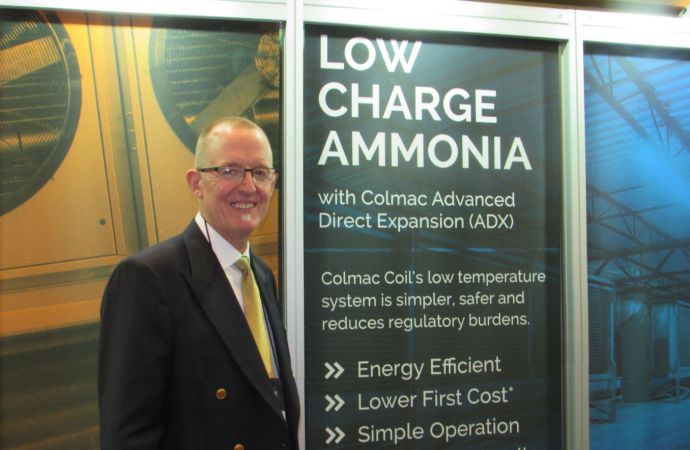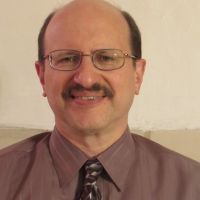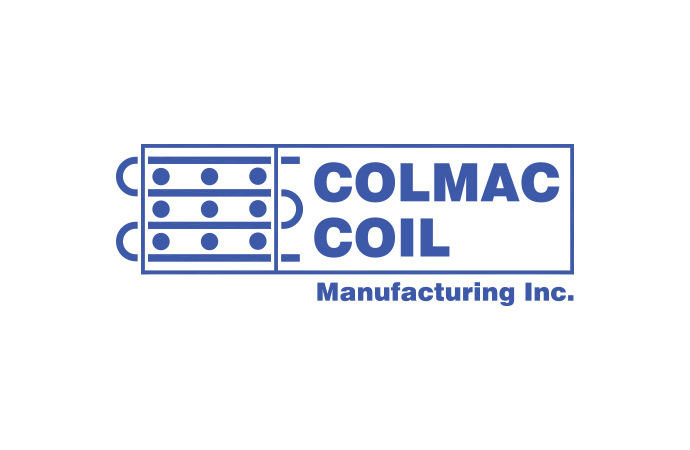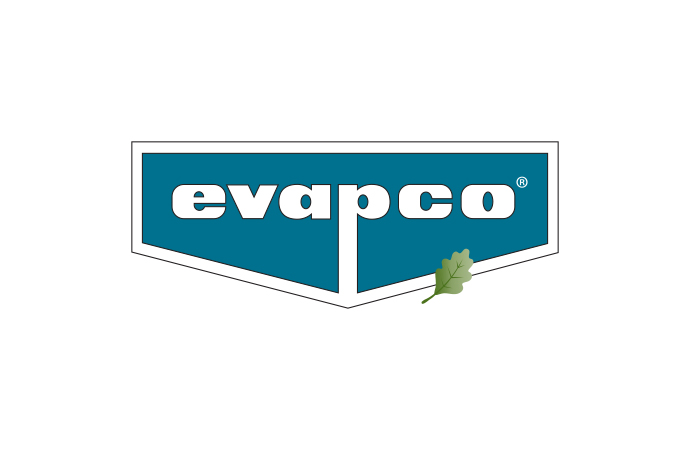For 10 of Accelerate America’s 25 Movers & Shakers driving natural refrigerant adoption, low-charge ammonia is a key part of their work.

Bruce Nelson, Colmac Coil Engineering, one of 10 Movers & Shakers in ammonia refrigeration.
In its November-December 2016 issue, Accelerate America magazine, published by shecco, listed 25 individuals (manufacturers, end users and one utility executive) who are driving the adoption of natural refrigerants in North America. Of those, 10 are involved with low-charge ammonia projects as a key part of their work.
The following are short profiles of these 10 people.
Original Equipment Manufacturers
Kurt Liebendorfer
Vice President, Evapco
Key Accomplishment: Heading the rollout of low-charge-ammonia Evapcold units.
Kurt Liebendorfer is leading the development and market introduction of the new Evapcold products, which are low-charge ammonia packaged refrigeration systems. The first Evapcold units were installed this year on the rooftop of Western Gateway Storage in Ogden, Utah. Evapcold units hold a charge of 2.5-5 lbs. of ammonia per TR. In helping the industrial refrigeration industry transition to low-charge systems, Liebendorfer has spoken publicly about the need for industry codes and standards to have a consistent definition of low-charge. He has also argued for codes and regulations to better reflect the lower risk posed by low-charge systems, which would reduce their cost.
John Scherer
Chief Technology Officer, NXTCOLD
Key accomplishment: Developed the NXTCOLD low-charge ammonia packaged system.
Worried about the possibility of a catastrophic ammonia leak at Los Angeles Cold Storage, where he is a longtime manager of engineering, John Scherer worked at night and on weekends for four years to develop the NXTCOLD low-charge packaged ammonia refrigeration system. Scherer has overseen installation of NXTCOLD units at LA Cold Storage at Lineage Logistics’ Oxnard, Calif., facility, and at a Baker Cold Storage facility in Long Beach, Calif. (under the supervision of Lineage), with 46 rooftop units. The NXTCOLD units carry an ammonia charge of 50 lbs. or less, or less than 1 lb. per TR, with a typical efficiency gain over traditional systems of 8%. Scherer is current chairman of the Global Cold Chain Alliance (GCCA) Refrigeration and Energy Committee.
Masood Ali
Global Leader of Center of Excellence for Alternative Systems, Heatcraft Worldwide Refrigeration
Key Accomplishment: Designed a low-charge/high efficiency NH3/CO2 cascade system installed at a Piggly Wiggly store.
Masood Ali has designed and validated systems such as a transcritical condensing unit with split cycle with two-stage compression, a trans-critical booster system with two-stage expansion for supermarkets, and a low charge-high efficiency NH3/CO2 cascade system for supermarkets and cold storage. The NH3/CO2 system is installed in a Piggly Wiggly store nearby Heatcraft’s facility in Columbus, Ga., the ammonia rack in the store was found to consume 22% less energy than an HFC rack Heatcraft installed in the store for comparison purposes. Ali is a member of ASHRAE, a corresponding member of ASHRAE 10.7, a member of the CANENA Technical Harmonization Sub-Committee, and a member of UL’s Joint Task Force for Flammable Refrigerants.
Component Manufacturers
Bruce Nelson
President, Colmac Coil Manufacturing
Key Accomplishment:
Developed low-charge-ammonia DX evaporators for low-temperature industrial applications. In 2014, Bruce Nelson’s company, Colmac Coil, tested and patented evaporator technology that for the first time supported low-charge industrial ammonia refrigeration using direct expansion (DX) at low temperatures in concert with a central machine room. DX ammonia had previously been limited to medium- and high-temperature systems. Colmac’s DX evaporator coil uses enhanced aluminum technology that reduces the ammonia charge to around 5 lbs./TR. Since then the technology has been implemented by Preferred Freezer Services, Shepherd’s Processed Eggs, Joliet Cold Storage and US Cold Storage, among others. Nelson is an active member of ASHRAE at both the local and national levels, and also serves as a director of IIAR (International Institute of Ammonia Refrigeration)
Joe Sanchez
Application Engineering Manager, Bitzer US
Key Accomplishment: Promoting the exchange of natural refrigerant technologies across the commercial and industrial sectors.
Joe Sanchez has gained some distinction in the natural refrigerants industry for coining the word “industrommercial,” which means “suitable or fit for industrial or commercial use.” The term It reflects the growing overlap of commercial and industrial applications of natural refrigerant technologies. In his many industry presentations, Sanchez is showing how each sector can make use of the other’s technology, with Bitzer providing compressors that serve both types. The exchange of technologies, he believes, will ensure the success of natural refrigerants. Sanchez is a member of IIAR, RETA and ASHRAE, and is also active with AHRI in the Compressors and Condensing Units section and its subcommittees.
End Users: Food Retail
Keith Milligan
CIO, JTM Corp. (Piggly Wiggly)
Key Accomplishment: Installing an NH3/CO2 cascade system in a store, and allowing energy comparisons to an HFC rack.
When JTM Corp. decided to open its 19th Piggly Wiggly store in Columbus, Ga., Keith Milligan decided it would use a refrigeration system tried in only three other stores in the U.S. – an ammonia/CO2 cascade system, the ammonia confined to the roof. The system was provided by Heatcraft Worldwide Refrigeration’s Kysor/Warren brand, whose factory is just 1.5 miles from the new store. Milligan allowed the store to serve as a test lab for Kysor/Warren, which installed an HFC rack there just so that a direct energy comparison could be made between the ammonia rack and the HFC rack. Over a four-month period, the ammonia rack was found to consume 22% less energy on average than the HFC rack. The store has become a showcase for other retailers to learn about using ammonia in supermarket refrigeration.
End Users: Industrial
Bing Cheng
Principal Utilities Engineer, Campbell Soup
Key Accomplishment: Overseeing conversion of Pepperidge Farm bakeries to low-charge ammonia packages.
Campbell Soup, winner of Accelerate America’s 2016 Best in Sector/Industrial Award, is a pioneer in the development of low-charge ammonia systems, led by its longtime head of refrigeration engineering, Bob Czarnecki. Bing Cheng, who succeeded Czarnecki last year, is carrying on this tradition. Under Cheng’s direction, Campbell continues to convert Pepperidge Farm bakeries from R22 and HFC to low-charge ammonia packages. Its latest conversion project in Lakeland, Fla., will employ Campbell’s first NH3/CO2 system. Cheng serves on IIAR’s standards committee, focusing on CO2 and insurance issues.
Michael Lynch
Vice President - Engineering, United States Cold Storage
Key Accomplishment: Managing rollout of NH3/CO2 systems.
Beginning in 2005, United States Cold Storage has led the cold storage industry in the installation of ammonia/CO2 cascade systems. With direction from Michael Lynch, the company now operates 12 plants with the technology, out of its 36 total facilities. Lynch has overseen these deployments since becoming vice president – engineering in 2011. Up until the last few years, many in the industry doubted the efficacy of NH3/CO2 refrigeration, but Lynch maintained US Cold Storage’s commitment to the system. Now it is becoming increasingly adopted as the advantages have become clear: no ammonia in the storage areas, much less ammonia charge, costs comparable to those of standard systems, and energy efficiency (5.8% more on average than conventional systems at US Cold Storage).
David Bornemeier
President and CFO, Western Gateway Storage
Key Accomplishment: Being the first end user of the Evapcold low-charge ammonia system.
New technology requires an end user willing to be the first to implement it. In the case of Evapcold, Evapco’s low-charge-ammonia packaged refrigeration system, that end user is Western Gateway Storage, Ogden, Utah, which installed two of the units on the rooftop of its new cold storage facility this year. Becoming the first user of the Evapcold system was the decision of David Bornemeier, an entrepreneur who, with his wife, Becky, purchased Western Gateway in 2011. Bornemeier was initially advised to invest in a less expensive Freon-based refrigeration system; but applying due-diligence skills honed as a financial analyst – including a willingness to ask “dumb questions” – he rejected that advice and went about investigating his options. He ultimately chose Evapcold, and discussed his reasons at the ATMOsphere America conference in June, including low charge, regulatory relief, first costs comparable to a conventional ammonia system and the expectation of 20% energy efficiency gains.
Utility
Paul Delaney
Senior Engineer, Southern California Edison
Key Accomplishment: Overseeing incentive programs for natural refrigerant equipment.
Utility energy incentives have become an important resource for end users seeking to reduce the first-cost of natural refrigerant systems, which typically have an energy-efficiency story to tell. Led by Paul Delaney, Southern California Edison is a utility that has taken a particular interest in supporting natural refrigerants through incentive programs. He has overseen energy-assessment projects leading to custom incentives for low-charge ammonia packaged systems. Southern California Edison continues to study the energy efficiency of low-charge ammonia units. Delaney is especially excited about the potential of low-charge ammonia for industrial and office-building air conditioning.
The following are short profiles of these 10 people.
Original Equipment Manufacturers
Kurt Liebendorfer
Vice President, Evapco
Key Accomplishment: Heading the rollout of low-charge-ammonia Evapcold units.
Kurt Liebendorfer is leading the development and market introduction of the new Evapcold products, which are low-charge ammonia packaged refrigeration systems. The first Evapcold units were installed this year on the rooftop of Western Gateway Storage in Ogden, Utah. Evapcold units hold a charge of 2.5-5 lbs. of ammonia per TR. In helping the industrial refrigeration industry transition to low-charge systems, Liebendorfer has spoken publicly about the need for industry codes and standards to have a consistent definition of low-charge. He has also argued for codes and regulations to better reflect the lower risk posed by low-charge systems, which would reduce their cost.
John Scherer
Chief Technology Officer, NXTCOLD
Key accomplishment: Developed the NXTCOLD low-charge ammonia packaged system.
Worried about the possibility of a catastrophic ammonia leak at Los Angeles Cold Storage, where he is a longtime manager of engineering, John Scherer worked at night and on weekends for four years to develop the NXTCOLD low-charge packaged ammonia refrigeration system. Scherer has overseen installation of NXTCOLD units at LA Cold Storage at Lineage Logistics’ Oxnard, Calif., facility, and at a Baker Cold Storage facility in Long Beach, Calif. (under the supervision of Lineage), with 46 rooftop units. The NXTCOLD units carry an ammonia charge of 50 lbs. or less, or less than 1 lb. per TR, with a typical efficiency gain over traditional systems of 8%. Scherer is current chairman of the Global Cold Chain Alliance (GCCA) Refrigeration and Energy Committee.
Masood Ali
Global Leader of Center of Excellence for Alternative Systems, Heatcraft Worldwide Refrigeration
Key Accomplishment: Designed a low-charge/high efficiency NH3/CO2 cascade system installed at a Piggly Wiggly store.
Masood Ali has designed and validated systems such as a transcritical condensing unit with split cycle with two-stage compression, a trans-critical booster system with two-stage expansion for supermarkets, and a low charge-high efficiency NH3/CO2 cascade system for supermarkets and cold storage. The NH3/CO2 system is installed in a Piggly Wiggly store nearby Heatcraft’s facility in Columbus, Ga., the ammonia rack in the store was found to consume 22% less energy than an HFC rack Heatcraft installed in the store for comparison purposes. Ali is a member of ASHRAE, a corresponding member of ASHRAE 10.7, a member of the CANENA Technical Harmonization Sub-Committee, and a member of UL’s Joint Task Force for Flammable Refrigerants.
Component Manufacturers
Bruce Nelson
President, Colmac Coil Manufacturing
Key Accomplishment:
Developed low-charge-ammonia DX evaporators for low-temperature industrial applications. In 2014, Bruce Nelson’s company, Colmac Coil, tested and patented evaporator technology that for the first time supported low-charge industrial ammonia refrigeration using direct expansion (DX) at low temperatures in concert with a central machine room. DX ammonia had previously been limited to medium- and high-temperature systems. Colmac’s DX evaporator coil uses enhanced aluminum technology that reduces the ammonia charge to around 5 lbs./TR. Since then the technology has been implemented by Preferred Freezer Services, Shepherd’s Processed Eggs, Joliet Cold Storage and US Cold Storage, among others. Nelson is an active member of ASHRAE at both the local and national levels, and also serves as a director of IIAR (International Institute of Ammonia Refrigeration)
Joe Sanchez
Application Engineering Manager, Bitzer US
Key Accomplishment: Promoting the exchange of natural refrigerant technologies across the commercial and industrial sectors.
Joe Sanchez has gained some distinction in the natural refrigerants industry for coining the word “industrommercial,” which means “suitable or fit for industrial or commercial use.” The term It reflects the growing overlap of commercial and industrial applications of natural refrigerant technologies. In his many industry presentations, Sanchez is showing how each sector can make use of the other’s technology, with Bitzer providing compressors that serve both types. The exchange of technologies, he believes, will ensure the success of natural refrigerants. Sanchez is a member of IIAR, RETA and ASHRAE, and is also active with AHRI in the Compressors and Condensing Units section and its subcommittees.
End Users: Food Retail
Keith Milligan
CIO, JTM Corp. (Piggly Wiggly)
Key Accomplishment: Installing an NH3/CO2 cascade system in a store, and allowing energy comparisons to an HFC rack.
When JTM Corp. decided to open its 19th Piggly Wiggly store in Columbus, Ga., Keith Milligan decided it would use a refrigeration system tried in only three other stores in the U.S. – an ammonia/CO2 cascade system, the ammonia confined to the roof. The system was provided by Heatcraft Worldwide Refrigeration’s Kysor/Warren brand, whose factory is just 1.5 miles from the new store. Milligan allowed the store to serve as a test lab for Kysor/Warren, which installed an HFC rack there just so that a direct energy comparison could be made between the ammonia rack and the HFC rack. Over a four-month period, the ammonia rack was found to consume 22% less energy on average than the HFC rack. The store has become a showcase for other retailers to learn about using ammonia in supermarket refrigeration.
End Users: Industrial
Bing Cheng
Principal Utilities Engineer, Campbell Soup
Key Accomplishment: Overseeing conversion of Pepperidge Farm bakeries to low-charge ammonia packages.
Campbell Soup, winner of Accelerate America’s 2016 Best in Sector/Industrial Award, is a pioneer in the development of low-charge ammonia systems, led by its longtime head of refrigeration engineering, Bob Czarnecki. Bing Cheng, who succeeded Czarnecki last year, is carrying on this tradition. Under Cheng’s direction, Campbell continues to convert Pepperidge Farm bakeries from R22 and HFC to low-charge ammonia packages. Its latest conversion project in Lakeland, Fla., will employ Campbell’s first NH3/CO2 system. Cheng serves on IIAR’s standards committee, focusing on CO2 and insurance issues.
Michael Lynch
Vice President - Engineering, United States Cold Storage
Key Accomplishment: Managing rollout of NH3/CO2 systems.
Beginning in 2005, United States Cold Storage has led the cold storage industry in the installation of ammonia/CO2 cascade systems. With direction from Michael Lynch, the company now operates 12 plants with the technology, out of its 36 total facilities. Lynch has overseen these deployments since becoming vice president – engineering in 2011. Up until the last few years, many in the industry doubted the efficacy of NH3/CO2 refrigeration, but Lynch maintained US Cold Storage’s commitment to the system. Now it is becoming increasingly adopted as the advantages have become clear: no ammonia in the storage areas, much less ammonia charge, costs comparable to those of standard systems, and energy efficiency (5.8% more on average than conventional systems at US Cold Storage).
David Bornemeier
President and CFO, Western Gateway Storage
Key Accomplishment: Being the first end user of the Evapcold low-charge ammonia system.
New technology requires an end user willing to be the first to implement it. In the case of Evapcold, Evapco’s low-charge-ammonia packaged refrigeration system, that end user is Western Gateway Storage, Ogden, Utah, which installed two of the units on the rooftop of its new cold storage facility this year. Becoming the first user of the Evapcold system was the decision of David Bornemeier, an entrepreneur who, with his wife, Becky, purchased Western Gateway in 2011. Bornemeier was initially advised to invest in a less expensive Freon-based refrigeration system; but applying due-diligence skills honed as a financial analyst – including a willingness to ask “dumb questions” – he rejected that advice and went about investigating his options. He ultimately chose Evapcold, and discussed his reasons at the ATMOsphere America conference in June, including low charge, regulatory relief, first costs comparable to a conventional ammonia system and the expectation of 20% energy efficiency gains.
Utility
Paul Delaney
Senior Engineer, Southern California Edison
Key Accomplishment: Overseeing incentive programs for natural refrigerant equipment.
Utility energy incentives have become an important resource for end users seeking to reduce the first-cost of natural refrigerant systems, which typically have an energy-efficiency story to tell. Led by Paul Delaney, Southern California Edison is a utility that has taken a particular interest in supporting natural refrigerants through incentive programs. He has overseen energy-assessment projects leading to custom incentives for low-charge ammonia packaged systems. Southern California Edison continues to study the energy efficiency of low-charge ammonia units. Delaney is especially excited about the potential of low-charge ammonia for industrial and office-building air conditioning.
Related stories






